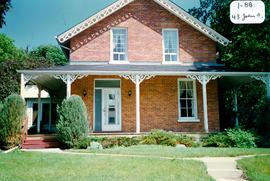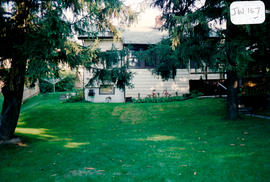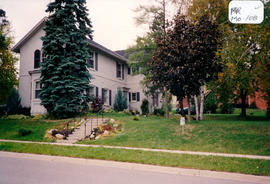The stately house located at 108 Moore Street (on the northwest corner of Moore and Frederick Streets) was built around 1880 in the Eclectic Gothic Revival style. Originally, it was the home of the Andrew Thompson family. He was the owner of a hardware business. There were extensive sheds (used to house their horses, buggies and feed) to the north of the house years ago. These sheds were eventually demolished and a two-car garage was built. In later years, this structure was the home of Lorne (Paul?) West and his family. They were followed by Norman (Dodger) and Jean Collings, who lived here for many years. This house was listed on the Bradford Heritage Registry in 2014.
The two-storey, ‘L’-shaped building has a medium-pitched, gable roof, an asymmetrical entrance, and large, asymmetrical window openings. There is a projecting, ground-floor bay window. The dropped finial at the front gable is another Gothic Revival feature. A simple and elegant portico with Doric columns and a projecting entablature is a neoclassical feature. There is a round-headed, sash window beneath the front gable and original, 2/2 wood, sash windows at the second floor. Replacement windows are found at the ground floor. The shutters are original. There is a projecting brick belt course and recessed brick panels (bay window), loadbearing, brick masonry construction, and a parged, stone foundation. According to the 2000 inventory, the house is well-maintained. (1, 2, 3)










